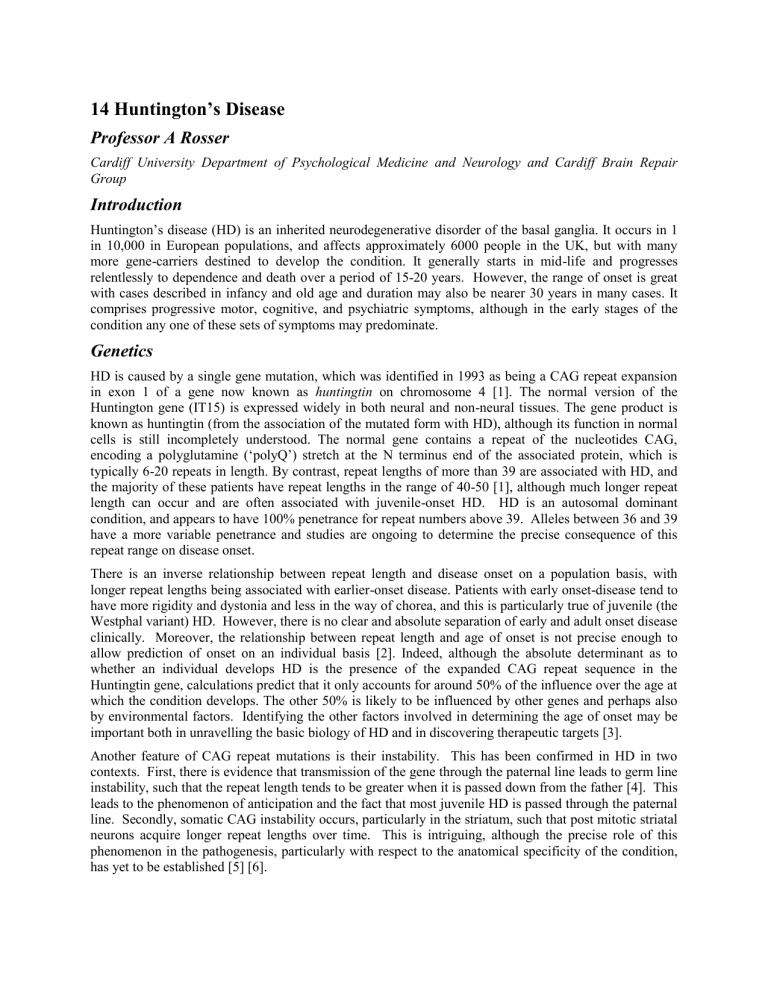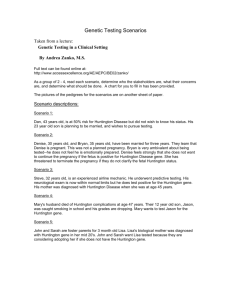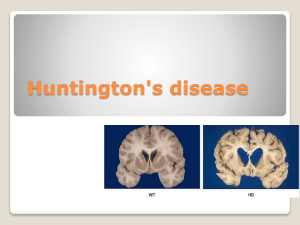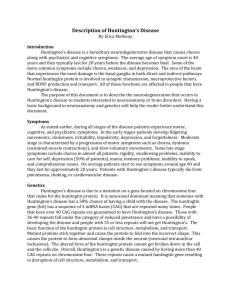14 Huntington`s Disease - The Movement Disorder Society

14 Huntington’s Disease
Professor A Rosser
Cardiff University Department of Psychological Medicine and Neurology and Cardiff Brain Repair
Group
Introduction
Huntington’s disease (HD) is an inherited neurodegenerative disorder of the basal ganglia. It occurs in 1 in 10,000 in European populations, and affects approximately 6000 people in the UK, but with many more gene-carriers destined to develop the condition. It generally starts in mid-life and progresses relentlessly to dependence and death over a period of 15-20 years. However, the range of onset is great with cases described in infancy and old age and duration may also be nearer 30 years in many cases. It comprises progressive motor, cognitive, and psychiatric symptoms, although in the early stages of the condition any one of these sets of symptoms may predominate.
Genetics
HD is caused by a single gene mutation, which was identified in 1993 as being a CAG repeat expansion in exon 1 of a gene now known as huntingtin on chromosome 4 [1]. The normal version of the
Huntington gene (IT15) is expressed widely in both neural and non-neural tissues. The gene product is known as huntingtin (from the association of the mutated form with HD), although its function in normal cells is still incompletely understood. The normal gene contains a repeat of the nucleotides CAG, encoding a polyglutamine (‘polyQ’) stretch at the N terminus end of the associated protein, which is typically 6-20 repeats in length. By contrast, repeat lengths of more than 39 are associated with HD, and the majority of these patients have repeat lengths in the range of 40-50 [1], although much longer repeat length can occur and are often associated with juvenile-onset HD. HD is an autosomal dominant condition, and appears to have 100% penetrance for repeat numbers above 39. Alleles between 36 and 39 have a more variable penetrance and studies are ongoing to determine the precise consequence of this repeat range on disease onset.
There is an inverse relationship between repeat length and disease onset on a population basis, with longer repeat lengths being associated with earlier-onset disease. Patients with early onset-disease tend to have more rigidity and dystonia and less in the way of chorea, and this is particularly true of juvenile (the
Westphal variant) HD. However, there is no clear and absolute separation of early and adult onset disease clinically. Moreover, the relationship between repeat length and age of onset is not precise enough to allow prediction of onset on an individual basis [2]. Indeed, although the absolute determinant as to whether an individual develops HD is the presence of the expanded CAG repeat sequence in the
Huntingtin gene, calculations predict that it only accounts for around 50% of the influence over the age at which the condition develops. The other 50% is likely to be influenced by other genes and perhaps also by environmental factors. Identifying the other factors involved in determining the age of onset may be important both in unravelling the basic biology of HD and in discovering therapeutic targets [3].
Another feature of CAG repeat mutations is their instability. This has been confirmed in HD in two contexts. First, there is evidence that transmission of the gene through the paternal line leads to germ line instability, such that the repeat length tends to be greater when it is passed down from the father [4]. This leads to the phenomenon of anticipation and the fact that most juvenile HD is passed through the paternal line. Secondly, somatic CAG instability occurs, particularly in the striatum, such that post mitotic striatal neurons acquire longer repeat lengths over time. This is intriguing, although the precise role of this phenomenon in the pathogenesis, particularly with respect to the anatomical specificity of the condition, has yet to be established [5] [6].
Practicalities of Predictive and Diagnostic Gene Testing
Predictive testing (i.e. genetic testing of asymptomatic individuals) is generally undertaken over the age of 18 years through the Medical Genetics services. Experience has demonstrated the need for at-risk individuals to be adequately prepared for the result and to properly explore whether they really want to know their gene status through counselling session administered by trained physicians and/or genetic counsellors. There are also issues of confidentiality and information distribution to family members that needs to be considered. Guidelines have been drawn up by the UK predictive consortium [7].
Diagnostic testing is performed in the context of a patient with symptoms and signs that would be compatible with a diagnosis of HD and would require further investigation if the HD gene test were to be negative. The test must be performed with the appropriate written consent and can be undertaken on a minor if appropriate with permission of the parents or guardian.
Pathology
At the macroscopic level, post-mortem studies reveal that the lateral ventricles become enlarged as the striatum degenerates, and this can be frequently detected in MR imaging during life [8]. The two main nuclei of the neostriatum (the caudate and the putamen) show progressive shrinkage and atrophy as the disease progresses, although of the two the caudate nucleus is affected earlier and to a greater extent than the putamen. The progression of shrinkage has been categorised into a series of stages, graded from 0 to 4
[9]. This system is very widely used for descriptive neuropathological staging of the disease. At the microscopic level the predominant cell loss is of the 'medium spiny' population of neurones, which constitute the major class of projection neuron in the striatum, and which use the inhibitory amino acid
GABA as their primary neurotransmitter. By contrast, the interneurones of the striatum are strikingly less affected by the disease. Although the striatum undoubtedly bears the burden of the pathology, other areas of brain, including selected areas of cortex, may be subtly involved even before overt symptoms occur
[10] [11], and in the advanced stages widespread cortical atrophy is common-place [12].
Although many of the downstream effects of this mutant gene have been identified in the years following identification of the gene, the mechanism by which the abnormal gene results in disease is not yet established, although there are a number of theories in the literature [13] [14] [15] [16].
. A more detailed understanding of these events will be necessary in order to design specific interventions to interfere with the disease process and slow disease progression. Cellular inclusions have been observed in both HD transgenic animals [17] and in post mortem human brains [18]. Thus, a relationship between the disease state and the inclusions seems likely, but the precise nature of this relationship, and whether the inclusions are part of the process of cell dysfunction and death or simply an associated epiphenomenon (or even neuroprotective), is as yet unclear [19].
Clinical Features
There has been much work over the last 15 years to better characterise the neurological and neuropsychiatric features if the disease. The most obvious and well-known motor feature of the disease is the choreiform movement. These are involuntary purposeless movements affecting the limbs, trunk, head, face, and bucco-oro-lingual regions. They may be the first noticeable feature of the condition, and at this stage it may be difficult to differentiate them from fidgeting. However, chorea may be subtle or absent altogether, and indeed, absence of choreiform movements is well described in Juvenile HD, but may be the case in adult-onset disease also.
Although choreiform movements can be one of the more striking features of HD, they often cause less disability than one would imagine. In the early stages, patients themselves may be unaware of the movements even when relatives are acutely aware of them [20], and successful reduction of chorea by medication is often disappointing in terms of restoring function. The reason for this is almost certainly that other co-existing motor abnormalities are responsible for as much, if not more, disability [21]. These include rigidity, bradykinesia, postural instability and dystonia. Bradykinesia and rigidity frequently co-
exist with the chorea and, in the absence of chorea, can lead to confusion and an erroneous diagnosis of
Parkinson’s disease. Dystonia may occur at any stage of the disease but is particularly prominent in more advanced patients in whom generalised dystonia may be a major management issue.
Balance is frequently affected early in HD, although patients usually remain ambulatory until the moderate to later stages. Movement of the eyes is often abnormal early on and progresses so that voluntary pursuit and saccadic eye movements may be virtually absent in advanced disease. Speech is often indistinct, even in the early to moderate stages, and may be associated with involuntary vocalisations (including fragments of speech, grunts, click and even shouts). It deteriorates progressively, becoming more effortful and difficult to understand, until the late stages during which most patients have very limited spontaneous vocalisation, are unintelligible, and may be mute. Although the speech disturbance in HD has been thought of as representative of dysarthria, there is increasing evidence that language is also affected in HD [22] [23] [24]. There is usually an accompanying dysphagia, manifest early on by choking and coughing on food and liquids, but progressing to marked difficulty swallowing, vomiting, and risk of aspiration, often leading to a requirement for PEG feeding.
The cognitive deficits in HD are characterised by a dysexecutive syndrome, memory deficits, impaired attention and reduced psychomotor speed [25] [26] and, although the motor symptoms may be the most apparent to the observer, the psychiatric and cognitive aspects of the disease contribute significantly to the misery and family stress associated with HD.
The common psychiatric manifestations of HD include depression and anxiety, irritability, rage attacks, disinhibition and obsessive compulsive disorder [27]. Drug and alcohol addition are also common and add to the management problems. The psychiatric manifestations are unpredictable in their appearance, and it can be difficult to know (even in retrospect) whether a bout of depression or other symptoms are
‘reactive’ or related specifically to the neurodegenerative process. The psychiatric and cognitive aspects of this condition contribute to the association of HD with socioeconomic decline and family break-up.
A number of other troublesome symptoms frequently complicate the course of HD [28], many of which may have their origin in hypothalamic, endocrine and metabolic abnormalities. As yet these symptoms have been relatively under-explored and are incompletely understood. Weight loss is a prominent
(although not universal) symptom, especially in advanced disease [29]. The cause remains unclear, although it may be multifactorial, including metabolic disturbance, anorexia, dysphagia, and the presence of involuntary movements [29] [30]. There is also a recognised association of sleep disturbance in HD , which may be due to disruption of circadian circuits [31]. Interestingly, there is recent evidence that imposing a sleep-wake cycle in transgenic HD mice can improve their cognitive function [32] [33].
The onset and duration of the pre-symptomatic phase is notoriously difficult to estimate clinically particularly when psychiatric symptoms, such as depression, precede motor or cognitive symptoms.
Depression is common in the general population and there are no clear specific features of depression when associated with HD, so that proving a bout of depression signalled the onset of the disease is usually not possible at present. There is also evidence that subtle cognitive decline may precede the clear onset of motor symptoms by a number of years [34]. There are currently no available biomarkers for the onset of
HD, although there are a number of initiatives world-wide to try to identify such markers. Two large multicentre studies setting out to discover biomarkers of disease onset are PREDICT-HD [35], which has been ongoing for several years and a more recently established study, TRACK-HD [36].
Management
The following is not intended to be exhaustive, but to act as a brief guide to the more common management needs. There are currently no disease-modifying treatments available for HD, although there is a coordinated international effort to identify such treatments (see below). However, until such therapies are available, treatment is centred around symptom management and support [37]. It is important that family members/friends are involved in the management plans for two reasons (i) The loss of insight,
poor motivation, intellectual decline, and behavioural disturbance associated with HD can make it difficult both to obtain an accurate picture of the patient’s disease status and social circumstances and also to engage the patient’s co-operation with the management plan, (ii) HD has a massive impact on family life and so both the patient and the carers need information and support. This is important if quality of life is to be maximised. HD is increasingly managed in specialist (often multidisciplinary) clinics in the
UK, although there are not yet sufficient clinics to provide full coverage. Some information about the location of HD clinics can be found on the EHDN website (www.euro-hd.net, network – locations – click on UK map ). Help and advise can be obtained from the Huntington’s Disease Association (HDA), which also provides regional HD advisors in many areas (www.hda.org.uk).
An important starting point for the management of HD is to recognise that, although chorea is often the most striking aspect of the disease, it may be the symptom least in need of treatment. Mild chorea may be much more troubling to relatives than to the patient who is often not fully aware of the presence of chorea, and reduction of chorea may have no impact on the patients function [20]. More severe chorea may have a functional impact and may also be tiring and uncomfortable for patients. The oldest and best – known antichoreic medication is Tetrabenazine, a VMAT-inhibitor which promotes the early metabolic degradation of dopamine. The principle drawbacks for its use in HD are depression (15%) and parkinsonism. 12.5mg tds is often sufficient to reduce the level of chorea without inducing undue drowsiness and parkinsonism. However, some of the newer anti-psychotic medications, such as
Olanzapine and Quietapine, have gained prominence as the first line choices amongst HD experts in the
UK as anectotally they appear to be as effective as tetrabenazine and possibly associated with fewer adverse effects. However, it is important to emphasise that to date there is very little in the way of an evidence base for any of these symptomatic therapies for HD. Unfortunately, many of the more disabling motor complications, such as dystonia, bradykinesia, and dysarthria, are much less amenable to treatment in HD. Pharmacological approaches to dystonia rarely appear to produce any sustained benefit, and although L-dopa may produce transient improvement in some patients with marked parkinsonian symptoms, the effect tends not to be sustained.
Some of the psychiatric symptoms such as depression and anxiety appear to be responsive, at least in part, to a range of medications used in conventional psychiatric practice, although other symptoms, such as the irritability, have proven to be more difficult to treat. There is anecdotal evidence that a number of drugs may reduce irritability levels, in particular Citalopram is currently in favour in the UK for this purpose, although again there is little in the way of an evidence base. Sadly, there is no treatment strategy for the cognitive impairment as yet [38] [37].
Non-pharmacological approaches are important, for example speech therapy input to assess and advise on the swallowing deficit, dietetic advise on nutrition, OT assessment of the home for mobility and care aids, and support from a social services. There is increasing recognition of the potential of physiotherapy and exercise, although again a dearth of evidence [39], and there is a systematic study of directed physical activities currently ongoing in the UK.
Future Directions
The international effort to understand more about HD has been fuelled both by a desire to find a treatment for an unpleasant destructive condition that frequently affects young people and by a recognition that HD provides a good model of neurodegeneration that is amenable to study and may inform how to treat neurodegeneration more generally. There has been a great deal of progress over the past 10 years, partly due to coordinated activity such as the European HD network (www.euro-hd.net) and its sister organisation the Huntington’s Study Group (HSG) in the USA (www.huntington-study-group.org). The emphasis has been on systematic longitudinal collection of clinical, biological and genetic data on large cohorts of patients, ranging from gene positive asymptomatic to severely affected, with a view to gaining a thorough understanding of the condition and also to developing a strategy for well-conducted clinical trials. In 2005 a Department of Health Dementias and Neurodegenerative Diseases Research Network
(DeNDRoN) was established to provide infrastructure for clinical research in a small number of disease areas, one of which is HD (www.dendron.org.uk).
Although ultimately a good understanding of the genetics and the pathways involved in cell death and dysfunction may be required in order to develop maximally effective treatments a number of parallel approaches can be undertaken in the interim to develop new treatments and develop an evidence base for existing treatments (reviewed in [40]). A number of studies have addressed the potential of putative neuroprotective agents. For example the growth factor CNTF has been found to ameliorate neurodegeneration caused by progressive metabolic toxic lesions of the striatum in experimental rats and monkeys, and small clinical studies of CNTF are now underway. A case has been made for testing broadacting neuroprotective compounds such as the anti-glutaminergic drug remacemide on the basis that excitotoxicity appears to play an important role in the disease process. Unfortunately, despite the fact that remacemide slowed disease progression in transgenic animals, a large clinical trial found no significant benefit in patients [41]. The same trial also evaluated the effect of an inhibitor of mitochondrial electron transport, coenzyme Q10, again without significant benefit. Since then there have been a number of double blind placebo controlled studies, including studies of riluzole and ethyl-EPA, none of which to date has demonstrated a significant positive outcome.
However, very recently (Feb 2010) the first positive outcome in a large double blind placebo controlled trial has been reported using the dopamine agonist, pridopidine, a so-called dopamine stabilizer
(www.neurosearch.com). The preliminary analysis has revealed a significant effect on involuntary movements – the full analysis is awaited.
Another therapeutic approaches is the systematic screening of known drugs for potential activity in HD using a cascade of screens going from test-tube, to culture models, to animal studies. The development of induced pluripotent stem (IPS) cell technology may have a significant impact on this sort of approach by greatly increasing the availability of cell culture systems carrying the human huntingtin mutation.
Reparative strategies such as tissue transplantation [42] illustrate yet another approach. As the brunt of cell dysfunction and loss is borne by the striatum, at least in the early to moderate stages of disease, the goal is to identify methods for replacing lost cells with fetal neuroblasts that can develop, integrate into the host circuitry, and thereby restore lost function. Clinical studies, in which primary fetal neuroblast were transplanted into the brains of patients with advanced Parkinson’s disease, have demonstrated benefit when the transplant methodology follows closely the biological principles established in animal experiments. On the basis of demonstrated benefit following striatal cell transplantation in animal models of HD, a small number of studies have now commenced in patients with HD. To date, these clinical studies have demonstrated the feasibility and safety of transplantation in this condition, but it will require several more years yet before the efficacy of the procedure can be confidently established. Ultimately the goal will be to use stem cells as the donor tissue [43].
Summary
HD is a devastating neurodegenerative condition for which there is currently no disease modifying treatment. A number of potential treatment strategies are being explored, but understanding the molecular and cellular events underlying the neurodegeneration in HD will be crucial for the development of truly rationale treatments for the future. It is envisaged that advances made in the treatment of HD will also lend insight into, and provide benefits for other currently untreatable neurodegenerative diseases.
References
1. A novel gene containing a trinucleotide repeat that is expanded and unstable on Huntington's disease chromosomes. The Huntington's Disease Collaborative Research Group. Cell, 1993. 72(6): p. 971-83.
2. Brinkman, R.R., Mezei, A., Thailman, J, The likelihood of being affected by Huntington's by a particular age, for a specific CAG size. American Journal of Human Genetics, 1997. 60: p. 1202-1210.
3. Gusella, J.F. and M.E. Macdonald, Huntington's disease: the case for genetic modifiers. Genome Med, 2009.
1(8): p. 80.
4. Pearson, C.E., Slipping while sleeping? Trinucleotide repeat expansions in germ cells. Trends Mol Med, 2003.
9(11): p. 490-5.
5. Kennedy, L. and P.F. Shelbourne, Dramatic mutation instability in HD mouse striatum: does polyglutamine load contribute to cell-specific vulnerability in Huntington's disease? Hum Mol Genet, 2000. 9(17): p. 2539-44.
6. Monckton, D.G. and C.T. Caskey, Unstable triplet repeat diseases. Circulation, 1995. 91(2): p. 513-20.
7. Guidelines for the molecular genetics predictive test in Huntington's disease. International Huntington
Association (IHA) and the World Federation of Neurology (WFN) Research Group on Huntington's Chorea.
Neurology, 1994. 44(8): p. 1533-6.
8. Thieben, M.J., et al., The distribution of structural neuropathology in pre-clinical Huntington's disease. Brain,
2002. 125(Pt 8): p. 1815-28.
9. Vonsattel, J.P., et al., Neuropathological classification of Huntington's disease. J Neuropathol Exp Neurol,
1985. 44(6): p. 559-77.
10. Tai, Y.F., et al., Microglial activation in presymptomatic Huntington's disease gene carriers. Brain, 2007. 130(Pt
7): p. 1759-66.
11. Wolf, R.C., et al., Dorsolateral prefrontal cortex dysfunction in presymptomatic Huntington's disease: evidence from event-related fMRI. Brain, 2007. 130(Pt 11): p. 2845-57.
12. Rosas, H.D., A.S. Feigin, and S.M. Hersch, Using advances in neuroimaging to detect, understand, and monitor disease progression in Huntington's disease. NeuroRx, 2004. 1(2): p. 263-72.
13. Rubinsztein, D.C., How does the Huntington's disease mutation damage cells? Sci Aging Knowledge Environ,
2003. 2003(37): p. PE26.
14. Landles, C. and G.P. Bates, Huntingtin and the molecular pathogenesis of Huntington's disease. Fourth in molecular medicine review series. EMBO Rep, 2004. 5(10): p. 958-63.
15. Lee, S.T. and M. Kim, Aging and neurodegeneration. Molecular mechanisms of neuronal loss in Huntington's disease. Mech Ageing Dev, 2006. 127(5): p. 432-5.
16. Kazantsev, A.G., Cellular pathways leading to neuronal dysfunction and degeneration. Drug News Perspect,
2007. 20(8): p. 501-9.
17. Davies, S.W., et al., Formation of neuronal intranuclear inclusions underlies the neurological dysfunction in mice transgenic for the HD mutation. Cell, 1997. 90(3): p. 537-48.
18. DiFiglia, M., et al., Huntingtin is a cytoplasmic protein associated with vesicles in human and rat brain neurons.
Neuron, 1995. 14(5): p. 1075-81.
19. Bates, G., Huntingtin aggregation and toxicity in Huntington's disease. Lancet, 2003. 361(9369): p. 1642-4.
20. Snowden, J.S., Craufurd, D., Griffiths, H.L., Neary, D. , Awareness of involuntary movements in Huntington disease. Archives of Neurology, 1998. 55: p. 801-5.
21. van Vugt, J.P., B.J. van Hilten, and R.A. Roos, Hypokinesia in Huntington's disease. Mov Disord, 1996. 11(4): p. 384-8.
22. Teichmann, M., et al., The role of the striatum in processing language rules: evidence from word perception in
Huntington's disease. J Cogn Neurosci, 2006. 18(9): p. 1555-69.
23. Teichmann, M., et al., The role of the striatum in sentence processing: evidence from a priming study in early stages of Huntington's disease. Neuropsychologia, 2008. 46(1): p. 174-85.
24. De Diego-Balaguer, R., et al., Striatal degeneration impairs language learning: evidence from Huntington's disease. Brain, 2008. 131(Pt 11): p. 2870-81.
25. Paulsen, J.S. and R.A. Conybeare, Cognitive changes in Huntington's disease. Adv Neurol, 2005. 96: p. 209-25.
26. Montoya, A., et al., Brain imaging and cognitive dysfunctions in Huntington's disease. J Psychiatry Neurosci,
2006. 31(1): p. 21-9.
27. Anderson, K.E. and K.S. Marder, An overview of psychiatric symptoms in Huntington's disease. Curr
Psychiatry Rep, 2001. 3(5): p. 379-88.
28. Aziz, N.A., et al., Hypothalamic dysfunction and neuroendocrine and metabolic alterations in Huntington's disease: clinical consequences and therapeutic implications. Rev Neurosci, 2007. 18(3-4): p. 223-51.
29. Hamilton, J.M., et al., Rate and correlates of weight change in Huntington's disease. J Neurol Neurosurg
Psychiatry, 2004. 75(2): p. 209-12.
30. Mahant, N., et al., Huntington's disease: clinical correlates of disability and progression. Neurology, 2003.
61(8): p. 1085-92.
31. Morton, A.J., et al., Disintegration of the sleep-wake cycle and circadian timing in Huntington's disease. J
Neurosci, 2005. 25(1): p. 157-63.
32. Pallier, P.N., et al., Pharmacological imposition of sleep slows cognitive decline and reverses dysregulation of circadian gene expression in a transgenic mouse model of Huntington's disease. J Neurosci, 2007. 27(29): p.
7869-78.
33. Pallier, P.N. and A.J. Morton, Management of sleep/wake cycles improves cognitive function in a transgenic mouse model of Huntington's disease. Brain Res, 2009. 1279: p. 90-8.
34. Paulsen, J.S., et al., Detection of Huntington's disease decades before diagnosis: the Predict-HD study. J Neurol
Neurosurg Psychiatry, 2008. 79(8): p. 874-80.
35. Paulsen, J.S., et al., Preparing for preventive clinical trials: the Predict-HD study. Arch Neurol, 2006. 63(6): p.
883-90.
36. Tabrizi, S.J., et al., Biological and clinical manifestations of Huntington's disease in the longitudinal TRACK-
HD study: cross-sectional analysis of baseline data. Lancet Neurol, 2009. 8(9): p. 791-801.
37. Bonelli, R.M. and P. Hofmann, A systematic review of the treatment studies in Huntington's disease since 1990.
Expert Opin Pharmacother, 2007. 8(2): p. 141-53.
38. Bonelli, R.M. and G.K. Wenning, Pharmacological management of Huntington's disease: an evidence-based review. Curr Pharm Des, 2006. 12(21): p. 2701-20.
39. Busse, M.E. and A.E. Rosser, Can directed activity improve mobility in Huntington's disease? Brain Res Bull,
2007. 72(2-3): p. 172-4.
40. Handley, O.J., et al., Pharmaceutical, cellular and genetic therapies for Huntington's disease. Clin Sci (Lond),
2006. 110(1): p. 73-88.
41. A randomized, placebo-controlled trial of coenzyme Q10 and remacemide in Huntington's disease. Neurology,
2001. 57(3): p. 397-404.
42. Rosser, A.E. and S.B. Dunnett, Cell transplantation for Huntington's disease. Lancet Neurol, 2006. 5(4): p. 284-
5.
43. Zietlow, R., et al., Human stem cells for CNS repair. Cell Tissue Res, 2008. 331(1): p. 301-22.








